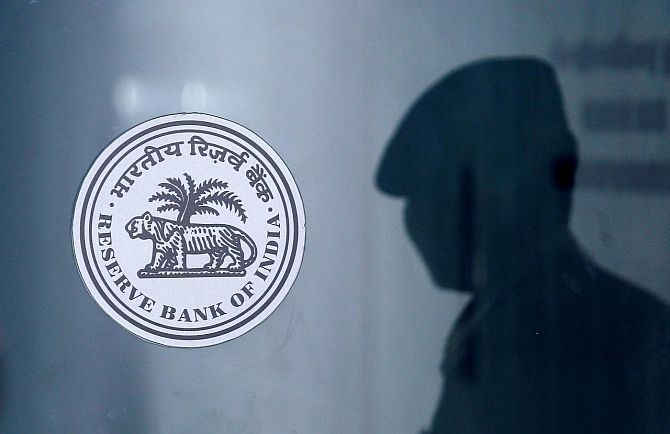Such cold-shoulder by banks also indicates a credit freeze that is hard to overcome, unless the government comes out with credit guarantee schemes for loans given by banks.
Since that is not happening, and there is no indication of that too, banks are not willing to listen to RBI prodding.

The Reserve Bank of India (RBI) has received bids for only about half the Rs 25,000 crore it offered under its revised Targeted Long Term Repo Operations (TLTRO), indicating that banks are reluctant to lend to non-banking financial companies (NBFCs).
Banks put in 14 bids worth Rs 12,850 crore for the three-year money offered.
In a similar auction on April 9, 18 bids were received for Rs 1.14 trillion as against the Rs 25,000 crore on offer.
In the first version of the TLTRO, there were no conditions attached, except that the money had to be deployed within 30 days.
It was later increased to 45 days.
The latest auction was part of the TLTRO 2.0, through which the RBI planned to infuse liquidity up to Rs 50,000 crore, to begin with.
The central bank had said half the money in the TLTRO 2.0 should go to small NBFCs.
This was necessitated after it was found that banks used the first lot of TLTRO money worth Rs 1 trillion to buy bonds of AAA-rated companies, including those issued by public sector units.
Top-rated companies don’t need emergency liquidity support anyway, and so the entire purpose of helping those in need was defeated.
The TLTRO 2.0 was introduced on April 17 in which the RBI put conditions that 10 per cent of the money should be used to buy securities issued by microfinance institutions (MFIs), 15 per cent for NBFCs with asset size of Rs 500 crore and below, and 25 per cent to buy securities of NBFCs sized between Rs 500 crore and Rs 5,000 crore.
According to a source, it is the private banks which stayed away from bidding for the TLTRO 2.0.
“Banks are in risk-off mode. The current priority is to preserve capital and reduce chances of existing exposures becoming default in future.
"So, there is less appetite for fresh exposures,” said the head of corporate banking and risk at a large foreign bank.
“The general wariness and perceived risk in funding to NBFCs have come to play mainly after the IL&FS crisis.
"Hence, as long as perceived credit risk is higher than TLTRO spread, banks will not invest,” said Abizer Diwanji, head of financial services at EY.
But there are critics of the whole TLTRO exercise too.
“The TLTRO route was a complicated way to direct money to NBFCs and MFIs.
"Already the RBI has given Rs 50,000 crore to institutions such as Sidbi, Nabard, and NHB to refinance MFIs, NBFCs.
"Hence, they should use the rest of the TLTRO money to such all-India financial institutions to not complicate matters further,” said Harsh Shrivastava, CEO of MFIN.
Executives in the NBFC industry, both big and small, were not aghast at such low bids.
“Banks bid only for 50 per cent of RBI’s line to NBFCs and MFIs. Complete risk aversion.
"RBI must give a direct line and FinMin must offer to bear first loss for some time.
"Let’s get our smaller but important lenders ready for the restart of our economy,” tweeted Sanjiv Bajaj, MD, Bajaj Finserv.
Although the RBI tried to provide liquidity to smaller NBFCs through the TLTRO 2.0, “the issue is smaller NBFCs will find it very difficult to issue bonds and getting them rated is another problem.
"So, their demand is direct term loans from banks,” said Raman Agarwal, co-chairman, FIDC.
The challenge seems to be that most of the banks do not have the segment of customers to deploy the funds, according to Aiswarya Ravi, CFO, Kinara Capital.
Also, the 45-day time limit may have made them uncertain on whether they can find such borrowers and do the due diligence and do on-lending.
“Now, the government should provide at least 10 per cent first-loss guarantee to banks.
"The RBI has offered banks funds at a low cost but banks seem to be unwilling to take the risk of lending to the NBFCs,” said Deo Shankar Tripathi, CEO of Aadhar Housing Finance.
Such cold-shoulder by banks also indicates a credit freeze that is hard to overcome, unless the government comes out with credit guarantee schemes for loans given by banks.
Since that is not happening, and there is no indication of that too, banks are not willing to listen to RBI prodding, experts say.
“This auction was a kind of a litmus test for banks’ risk appetite. This shows that banks are extremely risk-averse due to the uncertain credit environment,” said Soumyajit Niyogi, associate director, India Ratings & Research.
Banks continue to park over Rs 7 trillion of their surplus liquidity with the RBI on a daily basis.
Yet, they are not ready to extend the three-month moratorium to NBFC, forcing the para banking units to move to the court.
Banks are trying to figure what is the approach that they will use to deploy the funds availed under the TLTRO 2.0, said Krishnan Sitharaman, director, CRISIL.
Photograph: Francis Mascarenhas/Reuters
Abhijit Lele contributed to the story












 © 2025
© 2025